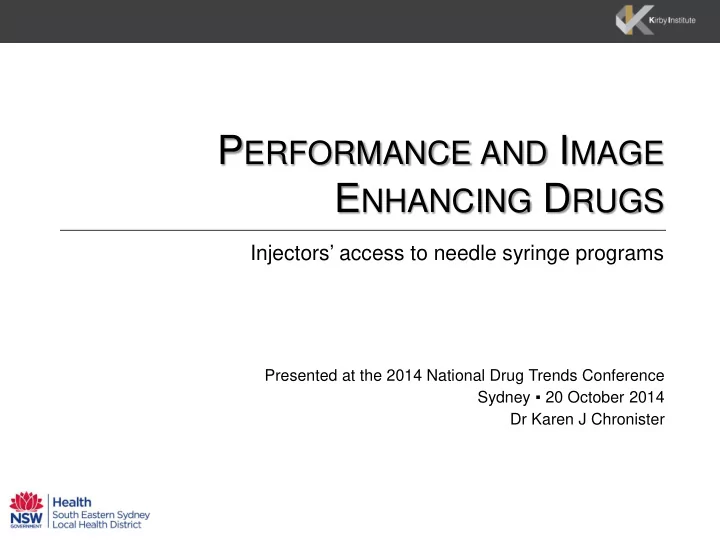

P ERFORMANCE AND I MAGE E NHANCING D RUGS Injectors’ access to needle syringe programs Presented at the 2014 National Drug Trends Conference Sydney ▪ 20 October 2014 Dr Karen J Chronister
Overview • Background • Survey results • Discussion and next steps
Kirketon Road Centre (KRC) • Service aim: to prevent, treat, and care for HIV/AIDS and other transmissible infections among the following target populations – People who inject drugs (PWID) – Sex workers – At risk young people (less than 25 years) • Needle and Syringe, outreach, and Methadone Access Programs integrated into a targeted primary health care model
Needle & Syringe Program (NSP) • An evidence based public health program that aims to protect the community from the spread of infections such as HIV and hepatitis C among people who inject drugs • Effects sustainable behaviour change among some of the most marginalised groups in society • Specifically designed to maximise access by people otherwise least likely to attend health services
Background • Increasing use of performance and image enhancing drugs (PIEDs) in recent years • Unknown size and nature of a largely ‘hidden’ population • PIED injectors increasingly accessing NSP to obtain free injecting equipment – Significant cost and capacity implications • Presents a significant public policy dilemma for the NSP, particularly in the context of removal of limits to increase coverage among PWID
The Survey • Aim: to assess blood-borne infection (BBI) risk among PIEDs injectors who access NSP services to inform appropriate service delivery • Participants: clients attending KRC’s NSP services who reported injection of PIEDs • Time period: November 2013 – January 2014 • Location: KRC and Clinic 180, both in Kings Cross
KRC or Clinic 180 Service Access First attendance Referral sources KRC, % Outreach Less than 3 months ago 28 Bus External 5% agency 3 – 6 months ago 0 6% 6 – 12 months ago 16 Internet 14% 1 – 5 years ago 42 More than 5 years ago 14 Other Word of 11% mouth - friends, partner, gym 64%
Sources of Injecting Equipment • 44% obtain injecting equipment for others • 55% obtain injecting equipment elsewhere – Pharmacy/chemist = 21 participants – Friends = 15 participants – Internet = 8 participants – Other NSPs = 7 participants – Doctor = 6 participants – Gym = 3 participants
Survey Participants • 103 participants – All but one participant was male • Mean age = 32.6 (± 8.5) years • 42% identified as gay or bisexual
Injecting History • 101 reported never re-using Age at first PIEDs injection injecting equipment after 40 someone else 35 30 • 6 participants ever 25 injected intravenously 20 – Mean age = 27.6 years 15 – None re-used or shared 10 equipment 5 – 1 HIV positive 0 Less than 25 - 34 35 - 44 45 years 25 years years years and older
Blood-borne Infections BBI Testing 35 • HIV prevalence HIV HCV 30 – 4 positive participants 25 – 52 never tested or did not answer 20 15 • Hepatitis C prevalence 10 – 0 positive participants 5 – 63 never tested or did not 0 answer
Comparing heterosexual and gay/bisexual participants Heterosexual Gay or bisexual N % N % P-value Age group 0.002 Less than 25 years 15 25.4 1 2.3 25 – 34 years 28 47.5 18 41.9 35 – 44 years 10 16.9 18 41.9 45 years and older 6 10.2 6 13.9 Age at first PIED injection 0.001 Less than 25 years 29 52.7 7 17.5 25 – 34 years 17 30.9 14 35.0 35 – 44 years 7 12.7 17 42.5 45 years and older 2 3.6 2 5.0 Ever injected intravenously 3 5.2 3 7.0 0.704 Ever tested for HIV 26 47.3 35 92.1 < 0.001 Ever tested for HCV 22 57.9 24 82.8 0.030
Other Factors • HIV positive (n=4) – All gay or bisexual and previously tested for HCV – 1 injected intravenously – None re-used equipment after someone else or been in prison • Prison history (n=1) – Did not inject in prison, re-use equipment after someone else, or inject intravenously
Health Service Needs Almost all said “no,” “none,” or “no thanks” You guys are doing a great job! Animal services
Conclusions • PIEDs injectors attending KRC have low BBI risk • Findings specific to KRC only – May be different in other NSP services • Continue to focus public health effort on those people who inject drugs who are at continuing high risk of BBI
Implications • Commenced provision of “stop-gap” packs – Limited quantity of needles and syringes, information re health risks specific to PIEDs use, injecting risk behaviour, BBIs, IRID, safer sex, and alternative sources of equipment • Promote BBI testing and other relevant services – Provide referrals as needed • Promote alternative sources of affordable equipment – Facilitate capacity of local pharmacies to meet needs
Acknowledgements • Co-authors A/Prof Ingrid van Beek and Mr Phil Tayler • KRC Frontline Services Unit • KRC clients • For further information, please contact: Kirketon Road Centre PO Box 22 Kings Cross NSW 1340 + 61 2 9360 2766
Recommend
More recommend